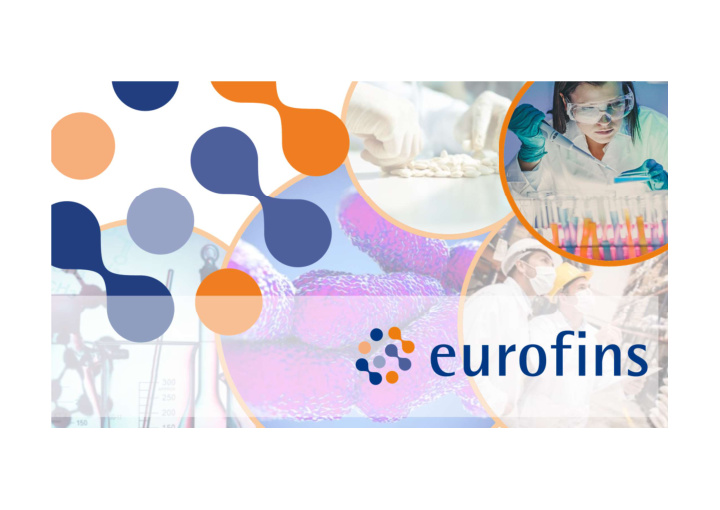



Eurofins Supplement Analysis Center Bailey Ireland, Hong You, Ph.D
Company History Celebrating 30 Years 2004 2001 Infrastructure 2005 Global Eurofins Founded 1997 2017 Building purchase and Growth Start Up lab expansion 1987 Infrastructure Expansion Growth thru Eurofins Start Acquisitions and Expansion thru up lab with 10 Investment in 2015 New Labs IPO in Paris. 2002 Infrastructure staff for SNIF- 30 Countries 10 Countries NMR 15 Countries 150 Labs 50 Labs 100 Labs 1 Country 1 Lab 1999 Rebranding to 1996 1982 2010 Eurofins Today Supplement Relocation Eurofins Analysis Center to Redwood ISO 17025 Alpha labs Globally recognized Acquisition Way founded testing leader 39 Countries 400 Labs
FDA Requirements Dietary Supplement Supplier/Manufacturing • Responsible for making sure their products are safe BEFORE they go to the market • Follow current Good Manufacturing Practice • Notify FDA of new ingredients • Report adverse events
Case Study #1 - Upgrade • Caffeine Reference Material to ISO 17034 Certified Reference Material
Case Study #1 - Upgrade • Caffeine – Upgraded RM – Reagent grade RM to CRM – Potential for higher quality RM • Improved measuring equipment and techniques • Reference Material Providers issue more information
Case Study #1 - Upgrade • Caffeine – Upgraded RM – Reagent grade RM to CRM – Potential for higher quality RM • Improved measuring equipment and techniques • Reference Material Providers issue more information
Case Study #1 - Upgrade • Reference Material – General Term – Can by quantitative or qualitative
Case Study #1 - Upgrade • Certified Reference Material – Characterized by valid procedures – Reference material certificate: specified properties, uncertainty, traceability – Relevant uncertainties reported
Case Study #2 – Checks and Balances • Hesperidin In-House Reference Material
Case Study #2 – Checks and Balances Bioflavonoids - HPLC-UV • Control Reference Material – Selection – Preparation • Issue: Hesperidin control results failing low
Case Study #2 – Checks and Balances RM Calculation Mode • Purity % calculated as HPLC Area % • Purity % calculated as HPLC % • HPLC % calculated based on calibration curve • RM inflated results in control chart • New control chart created with CRM • Consider RM quality and assay method
Case Study #3 – Reliable Sources • Troxerutin Investigation
Case Study #3 – Reliable Sources Troxerutin • High result bias in sample • Out of Specification (OOS) investigation – RM had high purity and low moisture content compared to other RM – Contacted Supplier • Samples re-tested before reporting • Vendor Evaluation for All Suppliers
Case Study #3 – Reliable Sources Vendor Evaluation • Quality Assurance – ISO Certification • Support – Expiration Dates – Certificate of Analysis – Assay Method – Phone and onsite support
Document and Report Systems eLIMS ComLIMS Master sample workflow tool Global test catalog SharePoint Internal log tracking and alert system eJIRA Updated D4 Electronic document management System Customer complaint and Investigation System
Documentation
Organizing and Storing RM • Storage information located on Certificate of Analysis • Label lab performance/R&D RM • Organize by assay method/use – Subcategories: Chemical name, Method, Method Test Family
Case Study #4 – R&D • B12 Method Development
Case Study #4 – R&D Vitamin B12 • Method Development • Issue: Co-eluting peaks • Analyte Identification – RT – Spectrum
Case Study #4 – R&D Optimization of HPLC condition – standard mixture Seems to be the best…
Methylcobalamine Water extraction Phosphate buffer extraction Methylcobalamine *
Reduce flow rate for better separation * * * *
Case Study #5 – Solubility • Hyaluronic Acid Method Validation
Case Study #5 – Reliable Sources Hyaluronic Acid-CE • Solubility Difference: – Hyaluronic acid sodium salt from rooster comb – Hyaluronic acid sodium salt from Streptococcus equi • Method validated RM • RM Changes – equivalent RM need to be evaluated
Case Study #6 – Calibration • Ginger Label Claim Recovery
Case Study #6 – Calibration ID Repeatability Claim Matrixces Sample form Estimated level Recovery code test result met? Ginger-HPLC-UV 1% Total nonvolatile ginger 251 Rhizome powder Raw material 1.10% 110% Yes constituents* 5% Total nonvolatile ginger 099 Rhizome dry extract Raw material 5.18% 104% Yes constituents • 3 of 12 samples OOS 0.3% Total nonvolatile ginger 875 Tablet Finished product 0.05% 17% No constituents* 0.03% Total nonvolatile 063 Tablet Finished product 0.03% 100% Yes – Capsaicin response factor ginger constituents* 2.51% total nonvolatile 580 Capsule Finished product 3.08% 123% Yes ginger constituents – Each analyte calibrated 0.50% 101 Liquid Capsule Finished product 0.58% zingerone 86% No zingerone Rhizome oleoresin - 50% Total nonvolatile ginger 986 Raw material 40.2% 80% No supercritical CO2 extract constituents Lean muscle recovery 0.01% 6- 648 Finished product 0.01% 6-Paradol 100% Yes supplement powder Paradol 420 Tincture Finished product Unknown 0.45% N/A N/A 5.10% Total nonvolatile 889 Softgel capsules Finished product 5.47% 107% Yes Ginger constituents 1% Total nonvolatile ginger 740 Rhizome powder Raw material 0.80% 80% No constituents* 692 Rhizome dry extract Raw material Unknown 3.64% N/A N/A * Estimated assuming ginger rhizome powder contains 1% total nonvolatile ginger constituents and ginger dry extract contains
Conclusion • Improving Reference Materials Quality • Quality Control • Correct RM Storage and Organization • Use RM to Identify • Source of RM Matters • Quantification Method
Recommend
More recommend